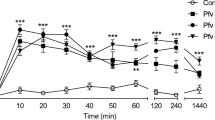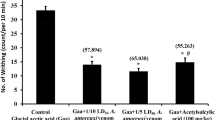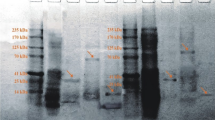Abstract
The pharmacological modulation of mice paw oedema produced byBothrops jararaca venom (BJV) has been studied. Intraplantar injection of BJV (1–30 μg/paw) produced a dose-and time-related oedema, which was maximal 30 min after injection, reduced gradually thereafter and disappeared over 48h. BJV heated at 100°C for 5 or 15 min blocked local hemorrhage and caused partial inhibition of its oedematogenic activity. The BJV oedema was not inhibited by the anti-histamine meclizine, the inhibitor of histamine and serotonin, cyproheptadine, PAF-acether antagonist WEB 2170 or by the anti-leukotrienes C4/D4, LY 171883. Dexamethasone, aspirin, indomethacin, and the dual cyclooxygenase and lipoxygenase inhibitor BW 755C inhibited BJV-induced oedema indicating that arachidonic acid metabolism products via the cyclooxygenase pathway participate in its genesis and/or maintenance. The antibothropic fraction (ABF) (25–200 μg/paw) isolated fromDidelphis marsupialis serum neutralized the oedema induced by the venom with and without heating, the hemorrhage induced by BJV and partially blocked the oedema induced by bradykinin and by cellulose sulphate. The oedema produced by histamine, serotonin, PAF-acether or leukotriene C4 was not inhibited.
Similar content being viewed by others
References
S. A. Minton Jr.,Snakes and snake venoms. InVenom Diseases, pp. 107–108, Thomas Springfield 1974.
G. G. Habermehl,Venomous animals and their toxins. InReptilia (Reptiles), pp. 130–180, Springer, Berlin 1981.
J. M. Gutiérrez, F. Chaves, R. Bolaños, L. Cerdas, E. Rojas, O. Arroyo and E. Portilla,Neutralización de los efectos locales del veneno de Bothrops asper por un antiveneno polivalente. Toxicon19, 493–500 (1981).
O. Vital Brazil,Peçonhas. InFarmacodinâmica. (Ed. C. E. Corbert), pp. 1044–1074, Guanabara Koogan, Rio de Janeiro 1982.
H. F. Deutsh and C. R. Diniz,Some proteolytic activities of snake venoms. J. Biol. Chem.216, 17–26 (1955).
J. M. Jiménez-Porras,Biochemistry of snake venoms. Clin. Toxicol.3, 389–431 (1970).
S. Iwanaga and T. Suzuki,Enzymes in snake venoms. InSnake Venoms, Handbook of Experimental Pharmacology, vol. 52 (Ed. C. Y. Lee) pp. 61–158, Springer, Berlin 1979.
B. B. Vargaftig, N. Bhargava and I. L. Bonta,Haemorrhagic and permeability increasing effects of “Bothrops jararaca” and other Crotalidae venoms as related to amine or kinin release. Agents and Actions4, 163–168 (1974).
A. Ohsaka,Hemorrhagic, necrotizing and oedema forming effects of snake venom. InSnake Venoms. Handbook of Experimental Pharmacology, vol. 52. (Ed. C. Y. Lee) pp. 480–546. Springer, Berlin 1979.
B. J. Hawgood,Physiological and pharmacological effects of rattlesnake venoms. InRattlesnake Venoms. Their Actions and Treatment. (Ed. T. Tu Anthony) pp. 121–162, Marcel Dekker, New York 1982.
B. Lomonte,Edema-forming activity of Bushmaster (Lachesis muta stenophrys) and Central American rattlesnake (Crotalus durissus durissus) venoms and neutralization by a polyvalent antivenom. Toxicon23, 173–176 (1985).
H. A. Trebien and J. B. Calixto,Pharmacological evaluation of rat paw oedema induced by Bothrops jararaca venom. Agents and Actions26, 292–300 (1989).
J. Vellard,Resistencia de los “Didelphis” (Zarigueya) a los venenos ofidicos. Rev. Brasil. Biol.5, 463–467 (1945).
M. Ovadia, B. Moav and E. Kochva,Factors in the blood serum of Vipera palaestinae neutralizing fractions of its own venom. Toxicon13, 113 (1975).
M. Ovadia and E. Kochva,Neutralization of Viperidae and Elapidae snake venoms by sera of different animals. Toxicon15, 541–547 (1977).
H. Moussatché, A. Yates, F. Leonardi and L. Borche,Experimentos sobre la resistencia del Didelphis venezolano (rabi-pelado) a los venenos de serpientes. Acta Cient. Venezolana29, 55 (1978).
J. C. Perez, W. C. Haws, V. E. Garcia and B. M. Jennings,Resistance of warm-blooded animals to snake venoms. Toxicon16, 375–383 (1978a).
J. C. Perez, W. C. Haws and C. H. Hatch,Resistance of woodrats (Neotoma micropus) to Crotalus atrox venom. Toxicon16, 198–200 (1978b).
H. Moussatché and F. Leonardi,Estudios de protección con sueros de mamiferos y reptiles a los venenos de serpientes Crotalidae. Acta Cient. Venezolana33, 151 (1981).
G. B. Domont, J. Perales and H. Moussatché,Natural antisnake venom proteins. Toxicon29, 1183–1194 (1991).
H. Moussatché, A. Yates, F. Leonardi and L. Borche,Mechanisms of resistance of the opossum to some snake venoms. Toxicon17, 130 (1979).
J. Perales, R. Muñoz and H. Moussatché,Isolation and partial characterization of a protein fraction from the opossum (Didelphis marsupialis) serum, with protecting property against the Bothrops jararaca snake venom. Ann. Acad. brasil. Ciênc.58, 155–162 (1986).
J. Perales, R. Muñoz, S. Graterol, O. Oviedo and H. Moussatché,New findings on the purification and characterization of an anti-bothropic factor from Didelphis marsupialis (opossum) serum. Brazilian J. Med. Biol. Res.22, 25–28 (1989).
H. Moussatché and J. Perales,Factors underlying the natural resistance of animals against snake venoms. Mem. Ins. Oswaldo Cruz84, 391–394 (1989).
S. H. Ferreira,A new method for measuring variations of rat paw volume. J. Pharmacol.31, 648 (1979).
J. M. Gutiérrez, O. Arroyo and R. Bolaños,Mionecrosis, hemorragia y edema inducidos por el veneno de Bothrops asper en ratón blanco. Toxicon18, 603–610 (1980).
L. S. Queiroz, H. Santo Neto, M. T. Assakura, A. P. Reichl and F. R. Mandelbaum,Pathological changes in muscle caused by haemorrhagic and proteolytic factors from Bothrops jararaca snake venom. Toxicon23, 341–345 (1985).
B. S. Vishwanath, R. M. Kini and T. V. Gowda,Characterization of three edema-inducing phospholipase A2 enzymes from habu (Trimeresurus flavoviridis) venom and their interaction with the alkaloid aristolochic acid. Toxicon25, 501–515 (1987).
H. S. Seliestre, L. S. Queiroz, O. A. B. Cunha, G. E. P. De Souza and J. R. Giglio,Isolation and characterization of hemorrhagic, myonecrotic and edema-inducing toxins from Bothrops insularis. Toxicon28, 261–273 (1990).
F. R. Mandelbaum, A. P. Reichl and M. T. Assakura,Some physical and biochemical characteristics of HF2 one of the hemorrhagic factors in the venom of Bothrops jararaca. Toxicon13, 109 (1975).
M. T. Assakura, A. P. Reichl and F. R. Mandelbaum,Comparison of immunological, biochemical and biophysical properties of three hemorrhagic factors isolated from the venom of Bothrops jararaca (jararaca). Toxicon24, 943–946 (1986).
F. R. Mandelbaum and O. B. Henriques,Purification and properties of Bothrops protease A. Arch. Biochem. Biophys.104, 369–375 (1964).
M. Rocha e Silva, W. T. Beraldo and G. Rosenfeld,Bradykinin, a hypotensive and smooth muscle stimulating factor released from plasma globulin by snake venoms and by trypsin. Am. J. Physiol.156, 261–273 (1949).
D. Haworth, J. R. M. Heron and F. Carey,Rat paw hyperalgesia and oedema in response to NMDA Naja naja phospholipase A 2. Br. J. Pharmacol.93, 145 (1988).
S. A. Minton,Polyvalent antivenin, in the treatment of experimental snake venom poisoning. Am. J. Trop. Med.3, 1077–1082 (1954).
M. Homma and A. T. Tu,Antivenin for the treatment of local tissue damage due to envenomation by southeast Asian snake. Ineffectiveness in the prevention of local tissue damage in mice after envenomation. Am. J. Trop. Med. Hyg.19, 880–884 (1970).
E. Martén,The surgical treatment of snake bite. InToxins: Animal. Plant and Microbiol. (Ed. P. Rosenberg) p. 417, Pergamon Press, Oxford 1978.
B. Lomonte, L. Cerdas, J. A. Gené and J. M. Gutiérrez,Neutralization of local effects of the terciopelo (Bothrops asper) venom by blood serum of the colubrid snake Clelia clelia. Toxicon20, 571–579 (1982).
H. Moussatché, F. Leonardi and F. Mandelbaum,Inhibición por una proteína aislada del suero de Didelphis marsupialis a la acción hemorrágica por una fracción del veneno de Bothrops jararaca. Acta Cient. Venezolana32, 173 (1981).
J. G. Soto, J. C. Perez and S. A. Minton,Proteolytic, hemorrhagic and hemolytic activities of snake venoms. Toxicon26, 875–882 (1988).
Author information
Authors and Affiliations
Rights and permissions
About this article
Cite this article
Perales, J., Amorim, C.Z., Rocha, S.L.G. et al. Neutralization of the oedematogenic activity of Bothrops Jararaca venom on the mouse paw by an antibothropic fraction isolated from Opossum (Didelphis Marsupialis) serum. Agents and Actions 37, 250–259 (1992). https://doi.org/10.1007/BF02028117
Received:
Accepted:
Issue Date:
DOI: https://doi.org/10.1007/BF02028117




